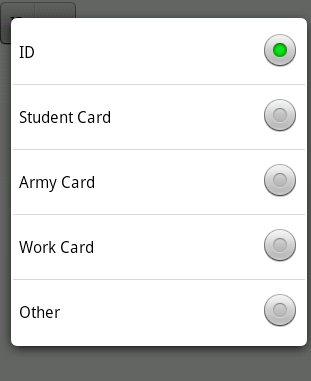通常情况下,如果列表选择框中要显示的列表项是可知的,那么可以将其保存在数组资源文件中,然后通过数组资源来为列表选择框指定列表项。这样就可以在不编写Java代码的情况下实现一个下拉选择框。
1.在布局文件中添加一个<spinner>标记,并为其指定android:entries属性,具体代码如下:
class="brush:csharp;gutter:true;"><LinearLayout xmlns:android="http://schemas.android.com/apk/res/android"
xmlns:tools="http://schemas.android.com/tools"
android:id="@+id/LinearLayout1"
android:layout_width="match_parent"
android:layout_height="match_parent"
android:orientation="vertical"
tools:context=".MainActivity" >
<Spinner android:entries="@array/ctype"
android:layout_width="wrap_content"
android:layout_height="wrap_content"
android:id="@+id/spinner"/>
</LinearLayout>
其中android:entries属性是用来指定列表项的,如果在布局文件中不指定该属性,可以在Java代码中通过为其指定适配器的方式指定;
2.编写用于指定列表项的数组资源文件,并将其保存在res\values目录中,这里将其命名为arrays.xml,在该文件中添加一个字符串数组,名称为ctype,具体代码如下
<?xml version="1.0" encoding="UTF-8"?>
<resources>
<string-array name="ctype">
<item>ID</item>
<item>Student Card</item>
<item>Army Card</item>
<item>Work Card</item>
<item>Other</item>
</string-array>
</resources>

在屏幕上添加列表选择框后,可以使用列表选择框的getSelectedItem()方法获取列表选择框的选中值,可以使用下面的代码:
Spinner spinner=(Spinner)findViewById(R.id.spinner);
spinner.getSelectedItem();
如果想要在用户选择不同的列表项后,执行相应的处理,则可以为该列表选择框添加OnItemSelectedListener事件监听器。例如,为spinner添加选择列表事件监听器,并在onItemSelected()方法中获取选择项的值输出到日志中,可以使用如下代码:
package com.basillee.blogdemo;
import android.os.Bundle;
import android.app.Activity;
import android.util.Log;
import android.view.View;
import android.widget.AdapterView;
import android.widget.AdapterView.OnItemSelectedListener;
import android.widget.Spinner;
public class MainActivity extends Activity {
@Override
protected void onCreate(Bundle savedInstanceState) {
super.onCreate(savedInstanceState);
setContentView(R.layout.activity_main);
Spinner spinner=(Spinner)findViewById(R.id.spinner);
spinner.setOnItemSelectedListener(new OnItemSelectedListener() {
@Override
public void onItemSelected(AdapterView<?> parent, View arg1,
int pos, long id) {
// TODO Auto-generated method stub
String result=parent.getItemAtPosition(pos).toString();//获取选择项的值
Log.i("spinner", result);
}
@Override
public void onNothingSelected(AdapterView<?> arg0) {
// TODO Auto-generated method stub
}
});
}
}
下面介绍通过指定适配器的方式指定列表的方式指定列表项的方法。
(1)创建一个适配器对象,通常使用ArrayAdapter类。在Android中,创建适配器通常可以使用以下两种方法:一种是通过数组资源文件创建;另一种是通过java里面的字符串数组创建。
ArrayAdapter<CharSequence> adapter=ArrayAdapter.createFromResource(this,R.array.ctype,android.R.layout.simple_dropdown_item_1line);
String[]ctype=new String[]{"ID","Student Card","Army Card"};
ArrayAdapter<String> adapter=new ArrayAdapter<String>(this, android.R.layout.simple_dropdown_item_1line,ctype);
(2)为适配器设置下拉列表的选项样式:
adapter.setDropDownViewResource(android.R.layout.simple_spinner_dropdown_item);
(3)将适配器与选择列表框关联:
spinner.setAdapter(adapter);